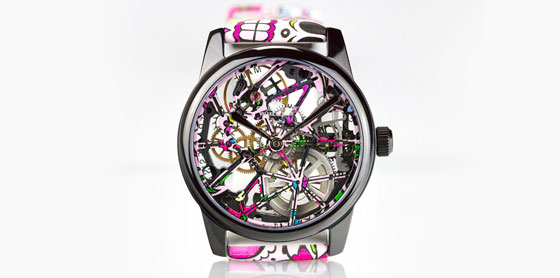
Vallorbe-based company Tec Arts has developed a water printing technique for watch components. A service that the company is alone in offering.
“I found a starting kit on the internet. The first attempts were disastrous, but I sensed that there was real potential.” Xavier Perrenoud tells the story of his industrial adventure much in the way that a passionate artisanal beer enthusiast might evoke his beginnings.
In 2016, after several months of development, this watch decoration specialist succeeded in adapting the water transfer printing technique to the world of micromechanics. This service that is unique in the world required a considerable number of adjustments in relation to its initial field of application: car bodywork. Today, his TecArts company – a subsidiary of Tec Ebauches in Vallorbe – has an ever-growing roster of clients both in the watch industry and beyond. It will present its latest advancements at the EPHJ.
Ink wrap
In 2015, Xavier Perrenoud was working for a company specialising in the decoration of watch components, ranging from traditional methods (circular graining, Côtes de Genève, etc.) through to galvanic plating and lacquering. His taste for innovation led him to discover water printing on the web. As he points out: “The watch industry was beginning to take an interest in innovative colouring processes, such as anodising aluminium and aerography (Editor’s Note: as in the RM 68-01 Cyril Kongo), but there was still nothing in the field of water printing.”
Invented in Japan during the 1980s, water printing mainly developed in the field of car and motorcycle tuning. The process consists of placing a water-soluble film containing the printed patterns on the surface of a dipping tank filled with warm water. After a few minutes, the substrate vanishes, leaving only a fine layer of ink floating on the liquid. Dipping an object of component into the tank enables the ink to wrap around the entire surface like a membrane, even on parts that are hard to access.
Necessary adjustments
“The problems is that bodywork standards bear no relation to those of the watch industry”, says Xavier Perrenoud. “I therefore needed to have competence hub in order to move ahead.” The youthful entrepreneur thus approached Arnaud Faivre, founder of the Tec Ebauches component factory, who was immediately won over. This was the start of a length and difficult process of adjustments involving every aspect of the method – starting with the chemical products used. To comply with the countless prescriptions governing the watch industry, such as resistance to perspiration and impacts, non-allergenic properties, etc., the varnishes and solvents were reformulated in-house. To ensure adhesion to materials such as sapphire, steel and aluminium, as well as to resist subsequent milling, the composition of the primary adhesive layer had to be entirely rethought. As too did the printing resolution, raised to 1,600 dpi in order to guarantee a prefect result. Finally, even though the total thickness of the primary layer, ink and protective lacquer amounts to no more than 10 to 12 hundredths of a millimetre, machining of the components had to be correspondingly adapted by that exact amount at Tec Ebauches.
Tec Arts was officially set up at the end of 2016 and its beginnings were promising. An initial presentation of the creative freedom afforded by water transfer printing caused a sensation at the EPHJ 2017. Case middles, bridges, mainplates and oscillating weights decorated in this way opened up an unprecedented field of exploration. “We are the only ones to offer this technique in watchmaking”, says Xavier Perrenoud. “It could be seen as a modern way of doing miniature painting.” Any pattern, colour or image can be printed in high resolution on the water-soluble film, before wrapping around any surface. This includes flexible applications such as to a metal watch bracelet, thanks to the dedicated development of a supple lacquer.
Several brands and subcontractors have adopted this technique, such as Claude Meylan, TockR and Vaucher Manufacture. “We are not aiming for the high-end sector”, admits the Technical Director, “but some haute couture Maisons also active in watchmaking are showing a keen interest. This is because water transfer printing makes it possible to recreate their entire universe, to reproduce their environment.”
May 31, 2018


 News
News